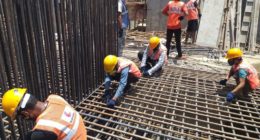Sydney, Australia, September 23, 2024 — A new report by Colliers and the Confederation of Real Estate Developers’ Associations of India (CREDAI) reveals that India’s real estate market is poised for significant expansion, potentially reaching a value of $10 trillion by 2047. This ambitious forecast anticipates an annual growth rate of 16%, driven by robust domestic demand, improving business conditions, and proactive governmental policies.
The report, titled “Indian Real Estate: The Quantum Leap,” identifies six key growth levers: rapid urbanization, infrastructure development, demographic shifts, digitalization, sustainability, and investment diversification. Together, these factors are expected to reshape the Indian real estate landscape, contributing to a projected 14-20% share of the nation’s GDP.
Urbanization and Demographics Fuel Demand
By 2050, the median age in India is projected to rise from approximately 30 to 40 years, with half the population expected to reside in urban areas. This demographic shift, combined with urbanization, is anticipated to generate significant demand across various real estate sectors, particularly residential, office, and retail markets.
Emerging segments such as senior living, co-living, and data centers are also set to experience substantial growth. As the population ages and consumer preferences evolve, investments in these alternative housing and service models are expected to surge.
Real Estate Hotspots on the Horizon
The report highlights the emergence of new real estate hotspots, particularly in tier II and III cities, as urban migration and infrastructure improvements create growth opportunities beyond major metropolitan areas. This expansion is likely to accelerate real estate development in peripheral regions of established cities.
Boman Irani, President of CREDAI National, emphasized the sector’s critical role in India’s economic future: “With the interplay of rapid urbanization and technological advancements, we are on the brink of a quantum leap, creating unprecedented demand across various real estate segments.”
Infrastructure and Policy as Catalysts for Growth
Infrastructure enhancements and a supportive regulatory framework are crucial to the long-term growth of the real estate sector. Initiatives such as the Real Estate (Regulation and Development) Act (RERA), the Pradhan Mantri Awas Yojana (PMAY), and REIT regulations have fostered greater transparency and investor confidence.
Manoj Gaur, Chairman of CREDAI National, highlighted the government’s focus on affordable housing and infrastructure modernization as transformative for both urban and rural landscapes. This commitment is expected to generate vibrant opportunities for developers and homebuyers alike.
Digitalization and Sustainability as Future Trends
The report underscores the growing importance of digitalization and sustainability in the real estate sector. Advanced technologies will play a pivotal role in optimizing operational efficiency, transparency, and accountability. Developers are increasingly expected to incorporate sustainable practices throughout the construction process, with green certifications becoming a standard requirement.
As India approaches its centenary year of independence, the real estate sector is anticipated to not only drive economic growth but also to evolve in response to shifting market dynamics and consumer preferences, setting the stage for a new era of development in the coming decades.
Also Read: At USD 2.5 Billion, Q2 2024 institutional investment in Indian real estate touches a 3-year high








